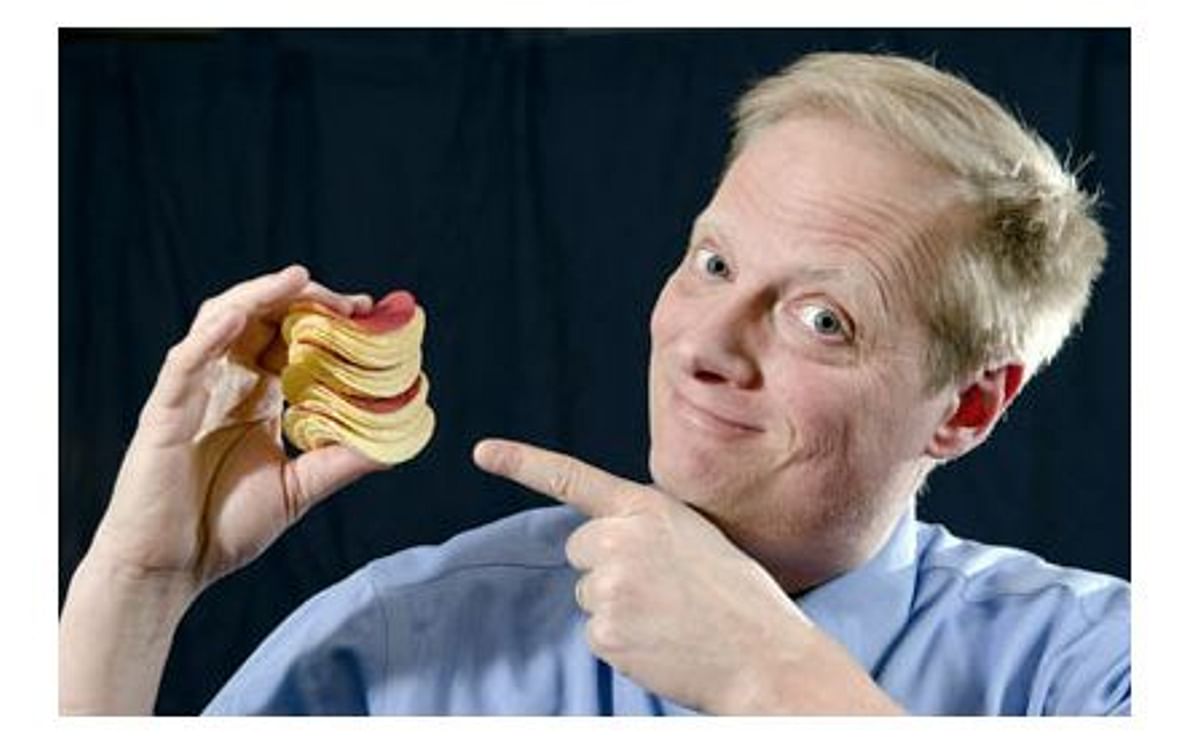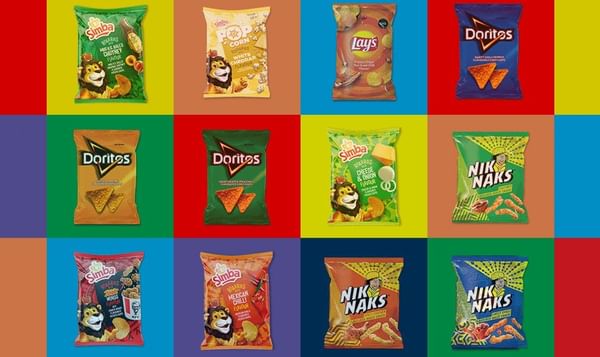Researchers at the University of Pennsylvania and Cornell University gave students one of two types of Lays' Stackable potato chips. The first group was given a stack of chips with red dyed, edible potato chips dividers that were interspersed at several different intervals, suggesting serving sizes anywhere from 5 to 14 chips. The other group was given the traditional stack of potato chips with no edible dividers.
What the researchers found was that inserting colored potato chips at regular intervals in the stacks caused people to eat fewer chips overall.
Here is how their research was described earlier in the Cornell Chronicle:
Once you pop the top of a tube of potato chips, it can be hard to stop munching its contents. But Cornell researchers may have found a novel way to help: Add edible serving size markers that act as subconscious stop signs.
As part of an experiment carried out on two groups of college students (98 students total) while they were watching video clips in class, researchers from Cornell's Food and Brand Lab served tubes of Lays Stackables, some of which contained chips dyed red.
In the first study of the research, which is published online this month in Health Psychology, a journal of the American Psychological Association, the red chips were interspersed at intervals designating one suggested serving size (seven chips) or two serving sizes (14 chips);in the second study, this was changed to five and 10 chips.
Unaware of why some of the chips were red, the students who were served those tubes of chips nonetheless consumed about 50 percent less than their peers: 20 and 24 chips on average for the seven-chip and 14-chip segmented tubes, respectively, compared with 45 chips in the control group;14 and 16 chips for the five-chip and 10-chip segmented tubes, compared with 35 chips in the control group.
They were also better able to estimate how many chips they had eaten. Those in the control groups underestimated the amount of chips they had consumed by about 13 chips. Those in the "segmented"groups were able to guess within one chip.
"People generally eat what is put in front of them if it is palatable,"said Brian Wansink, Cornell Food and Brand Lab director. "An increasing amount of research suggests that some people use visual indication -- such as a clean plate or bottom of a bowl -- to tell them when to stop eating."
"By inserting visual markers in a snack food package, we may be helping them to monitor how much they are eating and interrupt their semiautomated eating habits,"he added.
Wansink, the John Dyson Professor of Consumer Behavior and author of the best-seller "Mindless Eating: Why We Eat More Than We Think,"carried out the study with psychologists Andrew Geier of Yale University and Paul Rozin of the University of Pennsylvania.
"The effect demonstrated and replicated in these studies stands as perhaps the largest practicable procedure to decrease food intake in the literature,"Wansink said. "Marking modest portion sizes promises to be an effective strategy in the attempt to reduce food intake and obesity."
He noted that the experiment reduced caloric intake among participants by about 250 calories.
"Very modest reductions in intake produced by environmental changes can, when cumulated, lead to substantial weight loss,"Wansink said. "These studies could have major public health significance."
Wansink said further studies are needed among larger, more diverse groups to determine in what context segmentation cues work, exactly why they work and whether people will compensate for the reduction in food intake by eating more later.
Here is how their research was described earlier in the Cornell Chronicle:
Once you pop the top of a tube of potato chips, it can be hard to stop munching its contents. But Cornell researchers may have found a novel way to help: Add edible serving size markers that act as subconscious stop signs.
As part of an experiment carried out on two groups of college students (98 students total) while they were watching video clips in class, researchers from Cornell's Food and Brand Lab served tubes of Lays Stackables, some of which contained chips dyed red.
In the first study of the research, which is published online this month in Health Psychology, a journal of the American Psychological Association, the red chips were interspersed at intervals designating one suggested serving size (seven chips) or two serving sizes (14 chips);in the second study, this was changed to five and 10 chips.
Unaware of why some of the chips were red, the students who were served those tubes of chips nonetheless consumed about 50 percent less than their peers: 20 and 24 chips on average for the seven-chip and 14-chip segmented tubes, respectively, compared with 45 chips in the control group;14 and 16 chips for the five-chip and 10-chip segmented tubes, compared with 35 chips in the control group.
They were also better able to estimate how many chips they had eaten. Those in the control groups underestimated the amount of chips they had consumed by about 13 chips. Those in the "segmented"groups were able to guess within one chip.
"People generally eat what is put in front of them if it is palatable,"said Brian Wansink, Cornell Food and Brand Lab director. "An increasing amount of research suggests that some people use visual indication -- such as a clean plate or bottom of a bowl -- to tell them when to stop eating."
"By inserting visual markers in a snack food package, we may be helping them to monitor how much they are eating and interrupt their semiautomated eating habits,"he added.
Wansink, the John Dyson Professor of Consumer Behavior and author of the best-seller "Mindless Eating: Why We Eat More Than We Think,"carried out the study with psychologists Andrew Geier of Yale University and Paul Rozin of the University of Pennsylvania.
"The effect demonstrated and replicated in these studies stands as perhaps the largest practicable procedure to decrease food intake in the literature,"Wansink said. "Marking modest portion sizes promises to be an effective strategy in the attempt to reduce food intake and obesity."
He noted that the experiment reduced caloric intake among participants by about 250 calories.
"Very modest reductions in intake produced by environmental changes can, when cumulated, lead to substantial weight loss,"Wansink said. "These studies could have major public health significance."
Wansink said further studies are needed among larger, more diverse groups to determine in what context segmentation cues work, exactly why they work and whether people will compensate for the reduction in food intake by eating more later.












